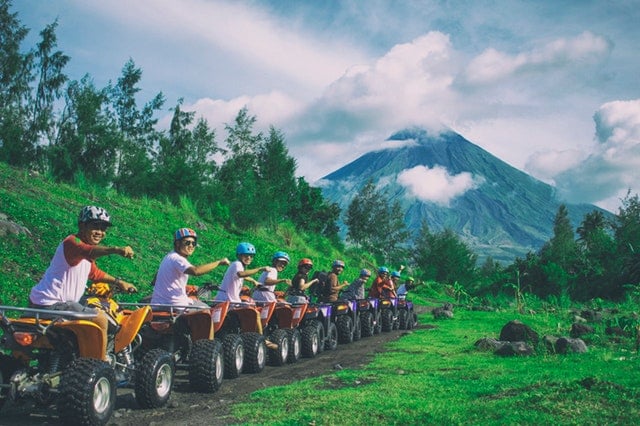Discover the Great Outdoors with Our Top ATV Adventures
Discover the Great Outdoors with Our Top ATV Adventures
Blog Article
ATV Riding Techniques: Understanding the Art of Off-Roading

Body Positioning
To efficiently navigate through difficult off-road surface, it is essential for ATV riders to constantly keep correct body placing. Keeping the correct body setting while riding an ATV not just improves control and stability yet also guarantees the biker's security. By embracing the proper body placing methods, motorcyclists can successfully distribute their weight, boost their equilibrium, and reduce the threat of accidents or injuries.
Placing the feet on the foot secures permits the cyclist to maintain security and control over the ATV. The rider's knees ought to be slightly bent, supplying a small suspension to soak up shocks and keep equilibrium.
Additionally, the cyclist's eyes need to always be focused in advance, scanning the terrain and expecting any kind of obstacles or adjustments in the trail. By preserving an ahead look, cyclists can make split-second choices and respond appropriately to testing surface.
Throttle Control
Building upon the significance of proper body positioning for ATV riders, grasping throttle control is a critical ability that allows riders to successfully navigate via different off-road terrains. Throttle control describes the capability to control the amount of power supplied to the ATV's engine. By understanding just how to control the throttle, riders can make sure a smooth and regulated velocity, permitting them to browse challenges with precision.
Unexpected or jerky movements can trigger the ATV to shed grip or become unpredictable, making it hard to maintain control. This strategy allows the ATV to maintain a consistent rate and offers better grip, decreasing the risk of accidents.
Along with smooth modulation, motorcyclists need to also find out just how to balance the throttle with various other riding methods, such as body positioning and braking. As an example, when climbing up high hills, riders need to apply adequate throttle to maintain momentum without creating or subduing the atv wheel spin. When coming down steep slopes, riders need to utilize the throttle in combination with proper body placing and braking to maintain control and stop the ATV from gliding or tipping over.

Braking Techniques
A vital aspect of ATV riding methods is grasping reliable braking methods. It is crucial to remember that harsh stopping with just the front brake can trigger the ATV to pitch forward, potentially leading to loss of control or even flipping over. By grasping these braking methods, you can improve your ATV riding abilities and make certain a satisfying and safe off-roading experience.
Cornering Techniques
One crucial aspect of grasping ATV riding techniques is understanding effective cornering techniques. Cornering on an ATV can be tough, yet with the best techniques, cyclists can browse turns see page securely and efficiently. The trick to successful cornering is to keep control of the ATV while maximizing traction and decreasing the threat of tipping over.
To implement a proper cornering strategy, motorcyclists should come close to the turn at a suitable rate, ensuring they are not going also fast or also slow-moving. It is critical to shift the body weight in the direction of the within the turn, leaning into it to keep equilibrium and security. This aids to counterbalance the centrifugal pressure and keeps the ATV upright.
Furthermore, riders ought to keep their eyes concentrated on the leave point of the turn instead than the immediate path in advance (ATV). This permits smoother and extra specific steering, as it helps the cyclist anticipate any barriers or changes in terrain
Additionally, correct throttle control plays a significant role in cornering. Bikers should regulate the throttle efficiently, staying clear of unexpected velocities or decelerations, which can cause loss of control.
Uphill and Downhill Riding
When browsing off-road terrain, ATV cyclists need to grasp the methods for uphill and downhill riding to maintain control and guarantee security. Uphill riding requires a mix of balance, throttle control, and weight circulation. As motorcyclists ascend high inclines, they ought to lean forward to change their weight in the direction of the front of the ATV, which increases grip on the front wheels and avoids the vehicle from flipping in reverse. ATV. Furthermore, keeping a consistent throttle and preventing sudden velocity or deceleration aids to stop the ATV from shedding energy or getting stuck. Downhill riding, on the other hand, calls for bikers to lean back and change their weight towards the rear of the ATV. This assists to maintain stability and stop the car from turning onward. It is vital to use the brakes moderately and use them progressively to avoid locking the site here wheels and blowing up. Bikers need to pick the course with the least barriers, as navigating downhill can be more tough due to the enhanced rate and lowered grip. By mastering the techniques for uphill and downhill riding, ATV cyclists can his response confidently take on various off-road surfaces and enjoy a secure and exhilarating journey.
Conclusion
To conclude, understanding the art of ATV riding needs a combination of body positioning, throttle control, stopping techniques, and efficient cornering. Uphill and downhill riding also call for particular abilities to navigate safely. By applying these techniques, motorcyclists can enhance their off-roading experience and enhance their overall control and safety on the ATV.
ATV Riding Techniques: Understanding the Art of Off-Roading is a detailed overview that delves right into the complexities of understanding the abilities required for off-road ATV riding. Whether you are a novice or a seasoned rider, ATV Riding Techniques: Mastering the Art of Off-Roading uses indispensable guidance to help elevate your off-road ATV riding skills to the next degree.

Report this page